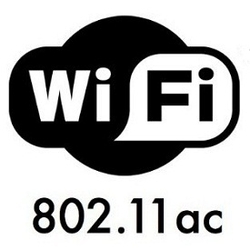
802.11ac is the next generation of Wi-Fi–the fifth, to be specific–and it is expected to be at least three times faster than 802.11n–in theory, as much as 10 times faster. The theoretical maximum speed of 802.11n is 600Mbps while 801.11ac boasts about 6.93 Gbps, although in reality that figure will be much lower, especially as the client devices get further away from the APs. Today, 802.11ac is a draft specification, with final 802.11 Working Group approvals and publication scheduled for late 2013/early 2014. However, there are already several APs and client devices out there. Client devices include Apple’s latest MacBook Air, Samsung Galaxy S4, and the HTC One.
So how does 802.11ac perform so much faster than 802.11n?
Simply put, Wi-Fi works by transmitting and receiving data streams using 20 MHz spectrum “spatial stream.” In 802.11n, the data streams that span the 20 MHz spectrum do so at 75 Mbps. To get more than 75 Mbps, two techniques are used–channel bonding and spatial stream multiplexing. In 802.11n channel bonding is done by combining two 20 MHz streams to get 40 MHz spectrum, or bandwidth of 150 Mbps per stream. With 802.11ac, more channels are bonded to get 80 MHz and eventually 160 MHz spectrum, which can carry 433 Mbps and 866 Mbps per stream, respectively. (Note: today’s 802.11ac devices do not support the 160 Mhz spectrum).
Beyond channel bonding, multiple spatial streams are multiplexed to achieve much higher bandwidth; this technique is called spatial stream multiplexing. With 802.11n, up to four spatial streams can be multiplexed for a theoretical max of 600 Mbps, although in practice, only three maximum spatial streams are multiplexed for a limit of 450 Mbps. In 802.11ac, up to eight spatial streams can be theoretically multiplexed for a maximum of 6.93 Gbps, although the practical limit will be a lot less.
Current 802.11ac devices in the market place are based on the first generation 802.11ac chipsets, known as wave-1. These devices currently perform at almost the same bandwidth as 802.11n because of the limitation in wave-1 chipsets. The limitations include: support of three streams maximum (rather than eight), no multi-user MIMO, and no 160 MHz wide channel support.
What is New in 802.11ac?
Operating in the 5GHz band. In the US, 5.0 GHz offers 23 non-overlapping channels and has less noise, which means higher bandwidth. However, it also means it has shorter range and does not penetrate solid objects well. This means more APs are needed.
- Wider channels (80MHz and 160MHz), which means more capacity in the band. (Note: 160 MHz is not supported in wave-1).
- Denser amplitude modulation with 256 QAM (Quadrature Amplitude Modulation), four times denser than 802.11n, which has 64 QAM.
- Downlink multi-user MIMO, which allows an AP to transmit to multiple clients simultaneously. (Note: not available in wave-1)
- Up to eight spatial streams, which doubles the number of spatial streams used in 802.11n (Note: in wave-1, only three spatial streams are supported).
- Beamforming: detects where devices are and intensifies the signal in their direction(s) to focus RF energy for better signal strength, rather than broadcast wireless signal equally in all directions.
Basic Comparison between 802.11n and 802.11ac:
| Key Features | 802.11n | 802.11ac | Remarks |
| Frequency | 2.4 and 5GHz band | 5GHz band only | 5Ghz has less noise, and a much greater number of non-overlapping channels |
| Channel bandwidth | 20 and 40 MHz | 20, 40, and 80MHz and maybe 160MHz | Increased performance through wider spectrum path |
| Spatial Streams | 1 – 4 Spatial Streams | 1 – 8 Spatial Streams
up to 4 per client |
Increased performance through “multi-lane highway” |
| Maximum theoretical speed | 600Mbps | 6.93 Gbps | Speed drops exponentially with distance in .11ac |
| Bandwidth per spatial stream | 150Mbps | 433Mbps | Almost all .11ac clients today are single-stream which is close to today’s practical 3-stream 802.11n data rates of 450Bbps |
| Key Features | 802.11n | 802.11ac | Remarks |
| Realistic bandwidth | 450 Mbps
Three stream (3×3) |
< 1 Gbps
(at close range) |
Speed drops exponentially in 802.11ac with further distance from AP |
| Multi-user MIMO | Not available | Optional but will not be available in first generation products | Allows a single 802.11ac device to transmit independent data streams to multiple different stations at the same time. |
| Beamforming | Proprietary | Standard | Detects where devices are and intensifies the signal in their direction(s). |
| Modulation | BPSK, QPSK, 16QAM, 64QAM | BPSK, QPSK, 16QAM, 64QAM and 256QAM modulation | Increased performance |
Article by Ali Kafel from https://www.techzone360.com/
More Networking News and Reviews


